The Google Pixel C Review
by Brandon Chester & Joshua Ho on January 25, 2016 8:00 AM ESTSystem Performance
One of the highlights of the Pixel C is the fact that it is powered by NVIDIA's Tegra X1 SoC. This technically isn't the first time that X1 has shown up in an Android device since it powers the SHIELD Android TV, but it's the first time it has been used in a mobile device. This implementation of Tegra X1 has four Cortex A57 cores with a peak frequency of 1.91GHz, along with four Cortex A53 cores. There are a few things that need to be mentioned about how Tegra X1 differs from other SoCs with eight cores. The first is the fact that in theory, Tegra X1 uses cluster migration rather than Heterogeneous Multi-processing. The reason I said in theory is because the implementation in the Pixel C is really only using the A57 cluster and scaling the frequency as low as 51MHz and as high as 1.91GHz.
In any case, all of our benchmarks should trigger the A57 cores in a mobile device that pairs A53 and A57 cores, so the discussion of the A53 cores being disabled is more relevant from a power consumption standpoint than a performance one. To analyze the general performance of the Pixel C I've run it through our standard JavaScript tests, along with PCMark and BaseMark OS II.
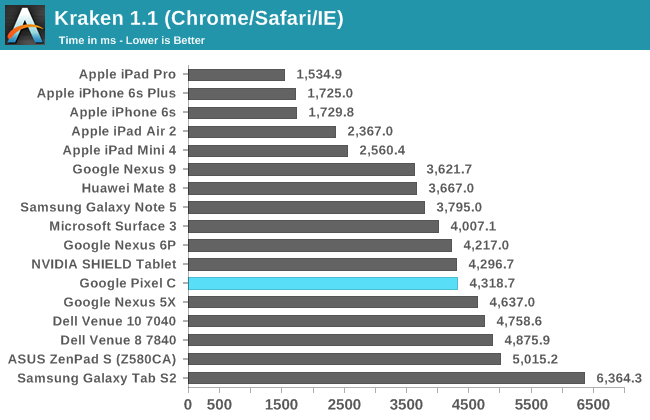
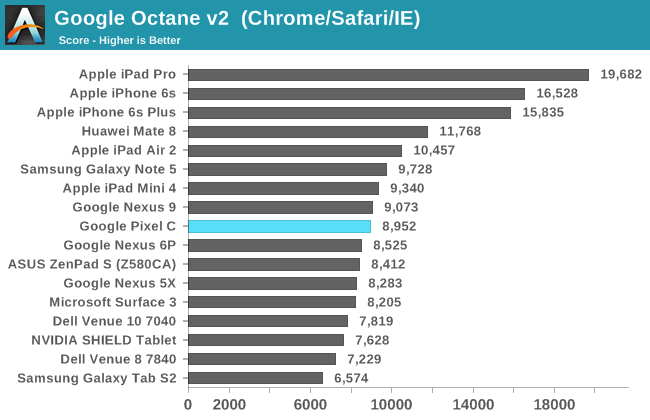

Unfortunately, the Pixel C doesn't make a very strong showing in our JavaScript benchmarks. I can't help but feel that this is the result of a rushed Android build, as there are regressions compared to the Nexus 9 in Octane and Kraken, and in all cases the score just isn't that impressive. JavaScript performance is definitely something Google will have to work on in the future, as the gap between the performance of iOS and Android devices is growing fairly large.

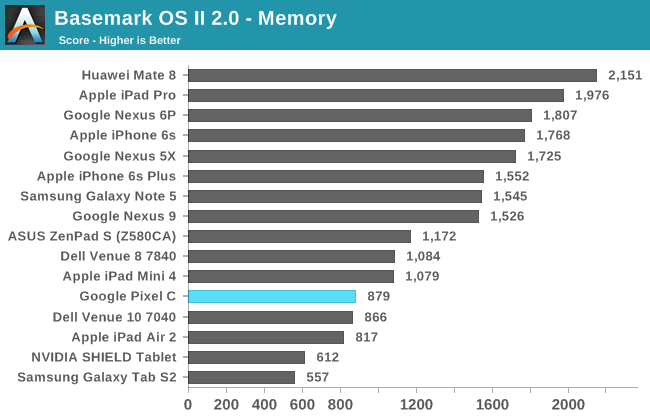
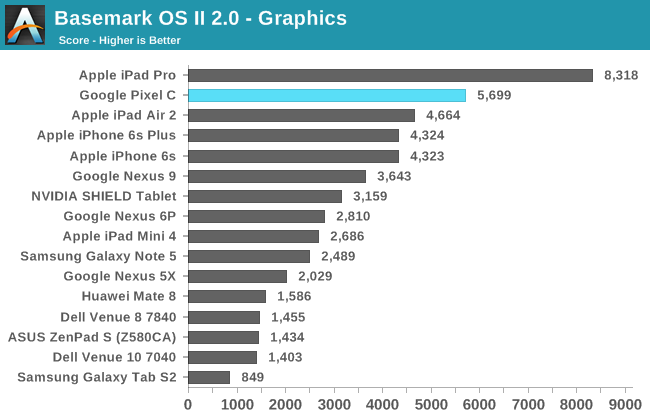


The Pixel C only achieves decent results in BaseMark OS II. The NAND memory score definitely drags down the overall rating, with the web score being lower than expected, and the system score being shocking low. The stand out score is in the graphics test, with the Pixel C only coming second to Apple's iPad Pro, and beating out the next best Android device, which is also NVIDIA-powered, by a huge margin. Unfortunately, high as it may be, Tegra X1's graphics performance just isn't enough to carry the Pixel C here.
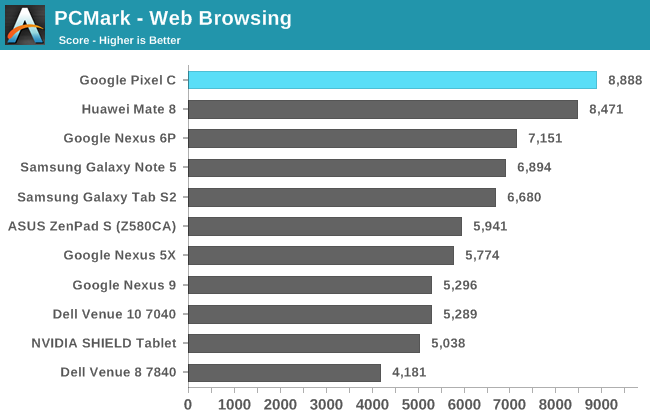
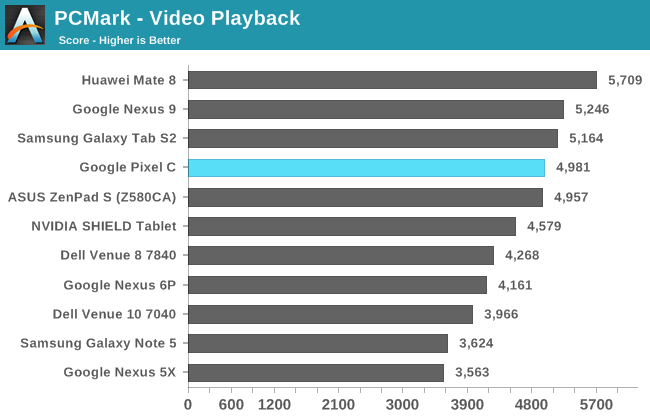

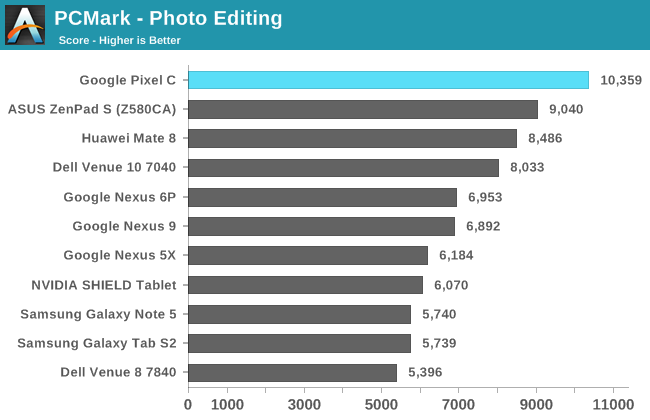
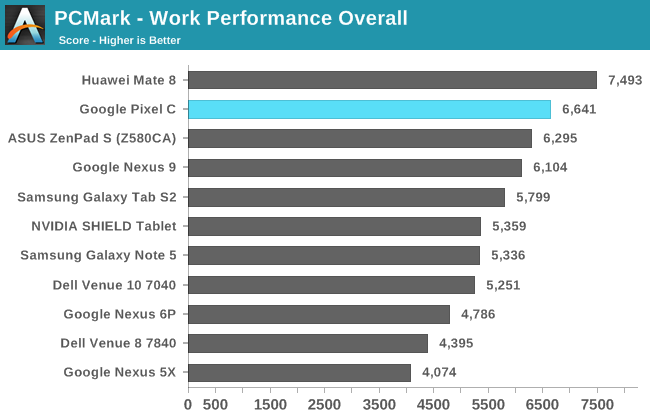
PCMark paints a different picture than BaseMark OS II, and highlights how performance can be highly variable based on workload, software, and whether an app is run as a native binary or through ART. In PCMark the Pixel C performs exceptionally well, with the exception of the writing test which seems to have been impacted by some change made to ART on Google's devices when moving to Marshmallow. Putting that aside, we see quite high and often chart topping scores in the remaining tests, resulting in a final score that only sits below the Huawei Mate 8.
Characterizing the Pixel C's performance is difficult. PCMark paints a very good picture, and I'm tempted to lean toward it as it is representative of the tasks that users will perform on a daily basis. There's a bit more discussion to be had about the Pixel C's general performance, and that'll come a bit later in the software section of the review. What I can say is that Tegra X1 certainly is fast as far as raw speed goes, but there's more to be said about the Pixel C's performance when you consider the role of both hardware and software.










122 Comments
View All Comments
jakeo2themax - Monday, January 25, 2016 - link
This could actually be a really compelling option for use in robotics, at least as a development platform. The Nvidia X1 is a phenomenal cpu/gpu for handling tasks like computer vision, and there are ubuntu builds I believe running on the X1. At $499 that's honestly great value. The Jetson tx1 dev kit is currently $600 on newegg, and if you don't need the extra clock speed and A53 cores then this could be awesome.deppman - Friday, January 29, 2016 - link
I'd look at the Shield TV pro for $299. Ubuntu has been running on that since July (see phoronix)Dobson123 - Monday, January 25, 2016 - link
"The core part of the keyboard uses the exact same key size, pitch, and travel distance as the Google Pixel C." What do you mean?xthetenth - Monday, January 25, 2016 - link
The keys are the same size, with the same distance between them and can depress the same amount as those on the Pixel C, but the keys on the edge are trimmed down to keep it small enough to fit. So the letters would be exactly the same.Ryan Smith - Monday, January 25, 2016 - link
Apologies, that was meant to be Chromebook Pixel and not the Pixel C.tipoo - Monday, January 25, 2016 - link
It's a little funny that the one area it seems to do ok in is battery life, when it doesn't seem to use the A53 cores, rather just power scaling the big cores...Now where does that leave big.LITTLE in terms of tablets at least...
kurkosdr - Monday, January 25, 2016 - link
So... they chose an Nvidia SoC... no wonder they have driver bugs.kron123456789 - Monday, January 25, 2016 - link
They use their own drivers, not Nvidia's. So, yeah, no wonder.ArthurG - Monday, January 25, 2016 - link
can we ban this trolll ? my Shield TV running same X1 Soc is ROCK SOLID under marshmallow and nvidia gaming support on Android is unmatched.Daniel Egger - Monday, January 25, 2016 - link
Probably the smartest move Google could make at this point is shipping a few devices to the Jide people to get RemixOS ported to it pronto and offer that rather than a naked Android.